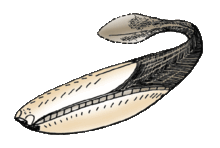Sacabambaspis
| Sacabambaspis Temporal range: Dapingian-Sandbian, 470–455 Ma | |
|---|---|
| | |
| Sacabambaspis fossil | |
| Scientific classification | |
| Kingdom: | Animalia |
| Phylum: | Chordata |
| Class: | †Pteraspidomorphi |
| Order: | †Arandaspidiformes |
| Family: | †Sacabambaspidae |
| Genus: | †Sacabambaspis Gagnier, Blieck & Rodrigo, 1986 |
| Type species | |
| †Sacabambaspis janvieri Gagnier, Blieck & Rodrigo, 1986 | |
| Species | |
| |
Sacabambaspis is an extinct genus of jawless fish that lived in the Ordovician period. Sacabambaspis lived in shallow waters on the continental margins of Gondwana.[1] It is the best known arandaspid with many specimens. It is related to Arandaspis.
Description

Sacabambaspis was 25 cm in length. The body shape of Sacabambaspis vaguely resembled that of a tadpole with an oversized head, flat body, wriggling tail, and lack of fins. It had characteristic, frontally positioned eyes, like car head lamps.[2]
Armor
Sacabambaspis had a head shield made from a large upper (dorsal) plate that rose to a slight ridge in the midline, and a deep curved lower (ventral) plate, this headshield is ornamented with characteristic oak-leaf shaped or tear-drop shaped tubercles.[3][4] Also it had narrow branchial plates which link these two along the sides, and cover the gill area.[3] The eyes were far forward and between them are possibly two small nostrils and they, which are surrounded by what is thought to be endoskeletal bone, and putative nostrils, are found at the extreme anterior of the head, one of the diagnostic features of the arandaspids.[3][4] The rest of body was covered by long, strap-like scales behind the head shield.[3]
Tail
The tail consists of relatively large dorsal and ventral webs and an elongated notochordal lobe, the posterior end of which is bordered by a small fin web. This tail structure clearly differs from that of heterostracans, which are currently grouped with arandaspids and astraspids in the clade Pteraspidomorphi (Gagnier 1993, 1995; Donoghue & Smith 2001; Sansom et al. 2005), in which the caudal fin looks diphycercal (i.e. symmetrical) and strengthened by a few large radials (Janvier 1996).[5]
Discovery and species
Genus named after the village of Sacabamba, Cochabamba Department, Bolivia, where the first examples were found.
- S. janvieri (Gagnier, Blieck & Rodrico, 1986), the type species, is known from Bolivia.[6] There are 30 known specimens of this Bolivian species, all crammed into a very confined area, believed to be the result of a fish kill, probably due a sudden inflow of freshwater from a large storm. They were found associated with a large number of lingulid brachiopods, also killed at the same time.[7]
- S. sp. (Young, 1997), is known from Central Australia.[6] Isolated scales found in the Horn Creek Siltstone from Central Australia have a very similar ornamentation to the Bolivian scales.[7]
- S. sp. (Albanesi & Astini, 2002), is known from Argentina.[6]
- S. sp.( Sansom et al, 2009), is known from Arabian Peninsula, Oman.[6] The Oman discoveries showed that the fish were present all around the margins of the ancient continent of Gondwana and not just in the southern regions as had previously been shown by the findings from South America and Australia.[1]
Paleobiology

Feeding
Although it had no jaws, the mouth of Sacabambaspis janvieri was lined with nearly 60 rows of small bony oral plates which were probably movable in order to provide more efficient suction-action through expansion and contraction of the oral cavity and pharynx.[7]
Sensory system
The fossils of Sacabambaspis show clear evidence of a sensory structure (lateral line system). This is a line of pores within each of which are open nerve endings that can detect slight movements in the water, produced for example by predators. The arrangement of these organs in regular lines allows the fish to detect the direction and distance from which a disturbance in the water is coming.[4]
See also
References
- 1 2 "How can something that small appear on TV?". Giles Miller. Retrieved 28 October 2013.
- ↑ Janvier, Philippe (1997) Arandaspida The Tree of Life Web Project.
- 1 2 3 4 Benton, Michael J. (2005). Vertebrate Palaeontology 3rd Edition. Blackwell Publishing. p. 47. ISBN 978-1-4051-4449-0.
- 1 2 3 Taylor & Francis (2001). PE Ahlberg (ed.) Major Events in Early Vertebrate Evolution. Sansom IJ, MM Smith & MP Smith. pp. 156–171.
- ↑ "The tail of the Ordovician fish Sacabambaspis". Biology Letters. Alan Pradel, Ivan. J Sansom, Pierre-Yves Gagnier, Ricardo Cespedes, and Philippe Janvier. Retrieved 28 October 2013.
- 1 2 3 4 "Pteraspidomorphi". After Carroll, 1988, and Janvier, 1997. Retrieved 28 October 2013.
- 1 2 3 "Australia: The Land Where Time Began". Retrieved 28 October 2013.
External links
- Pteraspidomorphi at Palaeos